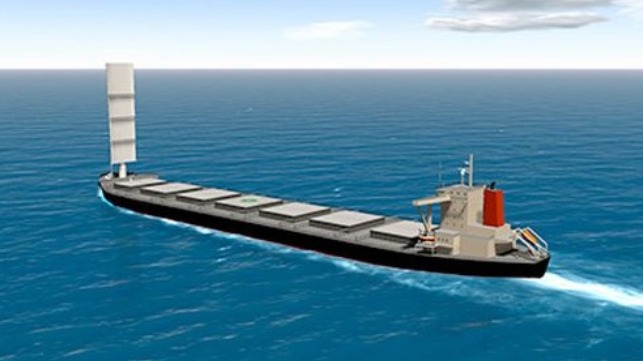Project Unites Wind Propulsion and Hydrogen Generation to Create Fuel

A new initiative is seeking to combine wind propulsion and hydrogen fuel to create a new generation of zero-emission shipping. The Wind Hunter Project will study combining wind propulsion sailing technology and wind energy converted to generate a stable supply of hydrogen.
Japan’s Mitsui O.S.K. Lines (MOL), which has already been exploring the use of wind sails, announced that it would be leading the project along with others including the National Maritime Research Institute (NMRI), Graduate School of Frontier Sciences of The University of Tokyo, Nippon Kaiji Kyokai (ClassNK) and industry leaders in Japan.
The project will seek to combine sail technology with hydrogen carriers and fuel cells. Using power from the vessel’s turbine they will also seek to generate hydrogen with an electrolyzer. In addition to making it possible for the vessel to sail in periods of low wind, the project team plans to study the potential of supplying hydrogen generated at sea for onshore use.
During periods of strong wind, a power generation turbine will produce power by rotating turbines in the water. As such, they will be using some of the vessel's propulsion to generate electric power. The electricity from the power generation turbine would in turn be used to operate the electrolyzer to produce green hydrogen. The vessel would also be equipped with hydrogen storage technology whereby the alloy would absorb and store on board the hydrogen produced during periods of strong wind. During periods of low wind, the storage alloy would release hydrogen to the fuel cells to power the ship and excess hydrogen not used during the voyage might be transferred to shore applications.
As a first step, the project team will conduct a feasibility study of the concept using a sailing yacht. They will seek to verify the function and performance through a series of cycle operations, i.e., turbine power generation, hydrogen generation/storage, and fuel cell-related propulsion. The next step would be a demonstration using a larger vessel.
MOL has already been actively pursuing the use of sail technology. In 2019, working with the Oshima Shipbuilding Co., MOL jointly obtained an "Approval in Principle (AIP)" from Nippon Kaiji Kyokai (ClassNK) for the design of a hard sail system. The system converts wind energy to propulsive force with a telescopic hard sail. MOL and Oshima Shipbuilding said they would continue to move toward a detailed design and implementation with the aim of launching a newbuilding vessel equipped with a hard sail as part of the Wind Challenger Project.
The Wind Challenger Project started in 2009 with the Wind Challenger Plan, an industry-academia joint research project led by The University of Tokyo. The project later gained the support of the Ministry of Land, Infrastructure, Transport, and Tourism and in 2018, MOL and Oshima Shipbuilding took charge of the plan playing a central role in the project.
The participants in the Wind Challenger project now include Ouchi Ocean Consultant, the National Maritime Research Institute (NMRI) of the National Institute of Maritime, Port, and Aviation Technology (MPAT), Smart Design Co., Graduate School of Frontier Sciences of The University of Tokyo, West Japan Fluid Engineering Laboratory Co., Nippon Kaiji Kyokai (ClassNK), and Miraihene Planning in addition to MOL and Oshima Shipbuilding.
